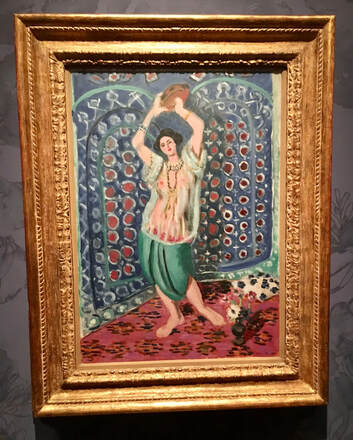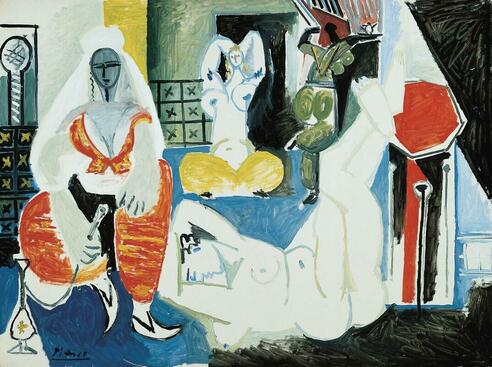 'Odalisque with Tambourine (Harmony in Blue)' by Henri Matisse' (1926) photo, from Norton Simon Museum 'Odalisque with Tambourine (Harmony in Blue)' by Henri Matisse' (1926) photo, from Norton Simon Museum I recently visited the small, but impressive collection of eight paintings in the Matisse/Odalisque exhibit at the Norton Simon Museum in Pasadena. The exhibition, showing until June 17, features four works of 'odalisques' that Henri Matisse painted over his career, as well works of the same subject by Picasso, Bazille, and Devéria. It’s a tremendous exhibit—Matisse’s works particularly. His colours and textures make for a gorgeous, visual experience, as does Picasso’s, Women of Algiers, Version I, an interesting and unique painting. My aim with this post is to help readers experience this lovely exhibition online or in person without feeling guilty for enjoying what some consider, politically-fraught art works that represent colonialism and female exploitation with images and ideas that romanticize harems of the ‘Orient’ (a term used by Europeans to refer to North Africa, Turkey or the Middle East during the 19th and 20th century). I also give some background to the works that will help visitors enjoy the paintings that much more, and I cut through the museum-speak of the exhibit labels. What’s the Exhibit About The exhibit’s focus is odalisques, a French term based on the Turkish word, 'odalık' which refers to female slave or harem concubine. Though it’s unlikely that the artists featured in this exhibit actually saw a harem in Turkey (a ‘harem’ being a separate part of a Muslim household reserved for women: wives, female servants and concubines of the male (polygamists) household leaders), they do however paint the female nude using themes from the 'orient' that include harem settings, costumes and textiles as backdrops. To appreciate the works in the exhibit it’s helpful to look at what was happening during the time the artists created the works. Artists typically don’t create in a bubble, but are influenced by current events, politics, cultural trends, even other artists’ works. We can then, view the works in the Matisse/Odalisque exhibit as a reflection of French culture during the time that the artists lived and worked (for the most part which between the late 19th and mid 20th century), which included at the time an interest in ‘oriental’ themes. We can see these themes in Matisse’s works with his use of fabrics, costumes, and the settings he created, particularly in Odalisque with Tambourine (Harmony in Blue). It’s a carefully staged scene where his model Henriette, (a professional model employed by Matisse) wore clothing that was influenced by Matisse’s daughter, who wore a similar costume to a carnival party when she dressed up as woman from a harem. Notice too the blue North African textile behind Henriette; it’s rich in detail and colour, as is the carpet at her feet. Matisse was known for collecting fabrics and textiles (usually picked up on his travels), which he used not only as backdrops but as focal points in his paintings. Do you think the woman is the focus in Odalisque with Tambourine (Harmony in Blue) or the blue cloth backdrop? One of the earlier works in the exhibit is Jean-Frederic Bazille’s Woman in Moorish Costume painted in his Paris studio in 1869. It takes a different approach, not using the harem setting as a backdrop (except for the sword on the wall and perhaps a tambourine on the floor?) but it focuses on the model, using her clothing as imagery associated with Orientalist themes. Nevertheless, her bare breast gives a sexual connotation.  'Women of Algiers, Version “I”', (1955) Pablo Picasso 'Women of Algiers, Version “I”', (1955) Pablo Picasso I’m a big fan of Picasso's works (not him as a person), and his painting in this exhibit, Women of Algiers, Version I is intriguing. Picasso did a series of paintings on the subject of odalisques, titled Women of Algiers, after Matisse’s death; this version is labeled ‘I’ (there's fifteen works in the series). Picasso was inspired by not only Matisse’s odalisques, but also by an 1834 painting, Women of Algiers in their Apartment, by Eugène Delacroix (see slide show). It’s an iconic harem scene based on Delacroix’s visit to a harem he experience on a trip to Morocco where he was allowed the unusual opportunity (for a European man) to visit within a Muslim harem. Yet when you look at Picasso’s Women in Algiers, Version I painting, it barely resembles either Delacroix’s work or Matisses’. But the painting is interesting; the colours are vibrant, the subjects exaggerated, strange. What do you think Picasso was thinking when he created this? It’s worth pondering; especially when looking at the paintings of the odalisques that inspired him. Clarifying the ‘Museum-speak’ I typically read the introductory labels that introduce an exhibition, and always appreciate those written in straightforward, non-scholarly language. Alas, they are hard to find, and though the Norton Simon is better than most, the exhibit label for the Matisse/Odalisque is a bit cumbersome as follows… “…yet his [Matisse] colorful and daring compositions revel in imagery, and excessively decorative environments that threaten to subsume the female subject altogether. The quest to create a harmonious relationship between figure and ground was one that Matisse paused throughout his career, but in the odalisque, he found a particularly, complex and compelling theme in which to further these ambitions” My 'Non-Museum' Translation Matisse’s paintings are stunning—the colours and patterns Matisse uses in his textiles, the rugs, bedspreads and backdrops are vibrant, bold and gorgeous, so much so they almost overpower his female subjects. Matisse was always striving to create harmony in his works between the subjects and his textured, colourful backgrounds, and even more so when he painted the female figure. The paintings of the odalisques in this exhibit showcase Matisse’s talent, how he was able to create compelling works that highlight his mastery of colour, texture and form. Enjoy! I hope you are able to view this exhibit in person, but if not, I’ve included the link to the exhibit below, along with another link to a previous Matisse exhibit at the Museum of Fine Arts in Boston that shares other works of Matisse that gives a different perspective.
If you want to go deeper into Matisse and the odalisque theme, see below.
0 Comments
Your comment will be posted after it is approved.
Leave a Reply. |
Museums for Real is a blog with insights and ideas on how to make museums relevant and enjoyable for everyone.
|